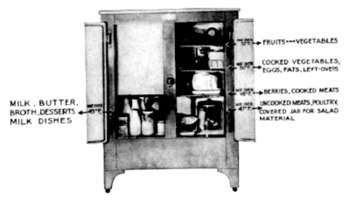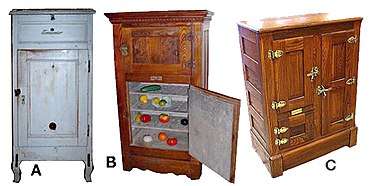Icebox

An icebox (also called a cold closet) is a compact non-mechanical refrigerator which was a common early-twentieth-century kitchen appliance before the development of safe powered refrigeration devices.
Design
Iceboxes had hollow walls that were lined with tin or zinc and packed with various insulating materials such as cork, sawdust, straw or seaweed. A large block of ice was held in a tray or compartment near the top of the box. Cold air circulated down and around storage compartments in the lower section. Some finer models had spigots for draining ice water from a catch pan or holding tank. In cheaper models a drip pan was placed under the box and had to be emptied at least daily. The user had to replenish the melted ice, normally by obtaining new ice from an iceman.
Iceboxes were commonly made of wood; many were handsome pieces of furniture.
Use

Iceboxes date back to the days of ice harvesting, which had hit an industrial high that ran from the mid-19th century until the 1930s, when the refrigerator was introduced into the home. Most municipally consumed ice was harvested in winter from snow-packed areas or frozen lakes, stored in ice houses, and delivered domestically as iceboxes became more common. In 1907 survey of expenditures of New York City inhabitants, 81% of the families surveyed were found to possess "refrigerators" either in the form of ice stored in a tub or iceboxes.[1] The widespread use of iceboxes was partially credited with reduction of US infant mortality in summer months.[2]
With metropolitan growth, many sources of natural ice became contaminated from industrial pollution or sewer runoff. As early mechanical refrigerators became available, they were installed as large industrial plants producing ice for home delivery. Able to produce clean, sanitary ice year-round, their product gradually replaced ice harvested from ponds.
With widespread electrification and safer refrigerants, mechanical refrigeration in the home became possible. With the development of the chlorofluorocarbons (along with the succeeding hydrochlorofluorocarbons and hydrofluorocarbons), that came to replace the use of toxic ammonia gas, the refrigerator replaced the icebox, though icebox is still sometimes used to refer to mechanical refrigerators.
See also
References
- ↑ Chapin, Robert Coit (1909). The Standard Of Living Among Workingmen's Families in New York City. New York: Charities Publication Committee. p. 136. Retrieved 30 April 2016.
- ↑ Kleinberg, S. J. (1989). The Shadow of the Mills: Working-Class Families in Pittsburgh, 1870–1907. Pittsburgh Series in Social and Labor History. Pittsburg: University of Pittsburgh Press. p. 108. ISBN 0822954451. Retrieved 1 May 2016.
Further reading
- Rees, Jonathan (2013). Refrigeration Nation: A History of Ice, Appliances, and Enterprises in America. Baltimore, MD: Johns Hopkins University Press.
External links
| Look up icebox in Wiktionary, the free dictionary. |